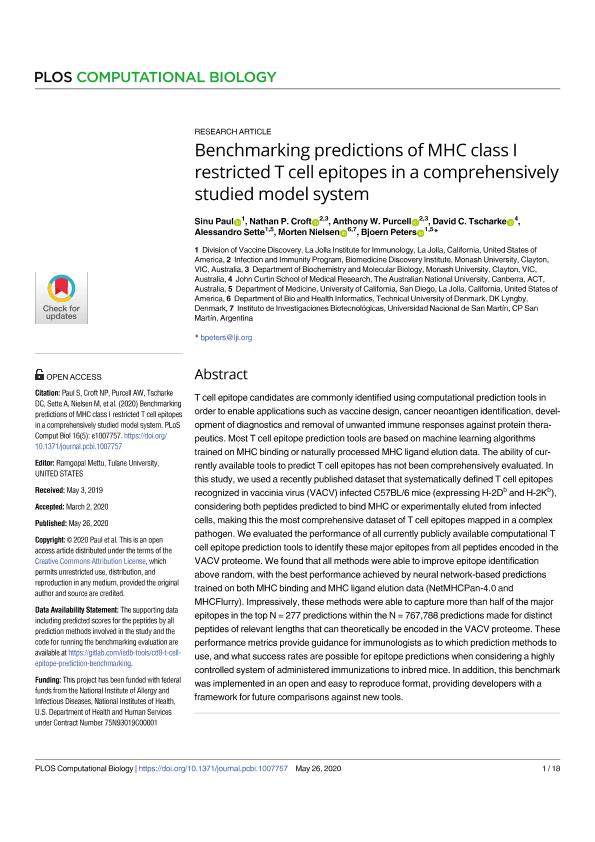Mostrar el registro sencillo del ítem
dc.contributor.author
Paul, Sinu
dc.contributor.author
Croft, Nathan P.
dc.contributor.author
Purcell, Anthony W.
dc.contributor.author
Tscharke, David C.
dc.contributor.author
Sette, Alessandro

dc.contributor.author
Nielsen, Morten

dc.contributor.author
Peters, Bjoern

dc.date.available
2020-08-21T18:02:05Z
dc.date.issued
2020-05
dc.identifier.citation
Paul, Sinu; Croft, Nathan P.; Purcell, Anthony W.; Tscharke, David C.; Sette, Alessandro; et al.; Benchmarking predictions of MHC class I restricted T cell epitopes in a comprehensively studied model system; Public Library of Science; Plos Computational Biology; 16; 5; 5-2020; 1-18
dc.identifier.uri
http://hdl.handle.net/11336/112153
dc.description.abstract
T cell epitope candidates are commonly identified using computational prediction tools in order to enable applications such as vaccine design, cancer neoantigen identification, development of diagnostics and removal of unwanted immune responses against protein therapeutics. Most T cell epitope prediction tools are based on machine learning algorithms trained on MHC binding or naturally processed MHC ligand elution data. The ability of currently available tools to predict T cell epitopes has not been comprehensively evaluated. In this study, we used a recently published dataset that systematically defined T cell epitopes recognized in vaccinia virus (VACV) infected C57BL/6 mice (expressing H-2Db and H-2Kb), considering both peptides predicted to bind MHC or experimentally eluted from infected cells, making this the most comprehensive dataset of T cell epitopes mapped in a complex pathogen. We evaluated the performance of all currently publicly available computational T cell epitope prediction tools to identify these major epitopes from all peptides encoded in the VACV proteome. We found that all methods were able to improve epitope identification above random, with the best performance achieved by neural network-based predictions trained on both MHC binding and MHC ligand elution data (NetMHCPan-4.0 and MHCFlurry). Impressively, these methods were able to capture more than half of the major epitopes in the top N = 277 predictions within the N = 767,788 predictions made for distinct peptides of relevant lengths that can theoretically be encoded in the VACV proteome. These performance metrics provide guidance for immunologists as to which prediction methods to use, and what success rates are possible for epitope predictions when considering a highly controlled system of administered immunizations to inbred mice. In addition, this benchmark was implemented in an open and easy to reproduce format, providing developers with a framework for future comparisons against new tools.
dc.format
application/pdf
dc.language.iso
eng
dc.publisher
Public Library of Science

dc.rights
info:eu-repo/semantics/openAccess
dc.rights.uri
https://creativecommons.org/licenses/by-nc-sa/2.5/ar/
dc.subject
MHC
dc.subject
Benchmark
dc.subject
Immunoinformatics
dc.subject.classification
Otras Biotecnologías de la Salud

dc.subject.classification
Biotecnología de la Salud

dc.subject.classification
CIENCIAS MÉDICAS Y DE LA SALUD

dc.title
Benchmarking predictions of MHC class I restricted T cell epitopes in a comprehensively studied model system
dc.type
info:eu-repo/semantics/article
dc.type
info:ar-repo/semantics/artículo
dc.type
info:eu-repo/semantics/publishedVersion
dc.date.updated
2020-07-01T17:02:49Z
dc.identifier.eissn
1553-7358
dc.journal.volume
16
dc.journal.number
5
dc.journal.pagination
1-18
dc.journal.pais
Estados Unidos

dc.description.fil
Fil: Paul, Sinu. La Jolla Institute for Allergy and Immunology; Estados Unidos
dc.description.fil
Fil: Croft, Nathan P.. Monash University; Australia
dc.description.fil
Fil: Purcell, Anthony W.. Monash University; Australia
dc.description.fil
Fil: Tscharke, David C.. The Australian National University; Australia
dc.description.fil
Fil: Sette, Alessandro. La Jolla Institute for Allergy and Immunology; Estados Unidos
dc.description.fil
Fil: Nielsen, Morten. Consejo Nacional de Investigaciones Científicas y Técnicas. Centro Científico Tecnológico Conicet - La Plata. Instituto de Investigaciones Biotecnológicas. Universidad Nacional de San Martín. Instituto de Investigaciones Biotecnológicas; Argentina. Technical University of Denmark; Dinamarca
dc.description.fil
Fil: Peters, Bjoern. La Jolla Institute for Allergy and Immunology; Estados Unidos
dc.journal.title
Plos Computational Biology

dc.relation.alternativeid
info:eu-repo/semantics/altIdentifier/url/https://dx.plos.org/10.1371/journal.pcbi.1007757
dc.relation.alternativeid
info:eu-repo/semantics/altIdentifier/doi/http://dx.doi.org/10.1371/journal.pcbi.1007757
Archivos asociados
